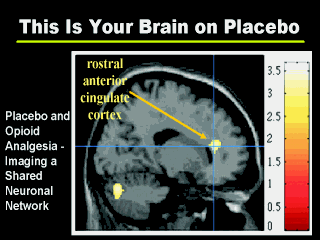 Petrovic, PP et al. February 7 2002;
10.1126/science.1068836,
Science Express Reports |
Now, the latest part of this saga relates to this picture in
Science Online, which the editors captioned, “This is your brain on placebo.” This
again is a PET scan, and what was done here is to take volunteers and to put a hot metal
plate on the back of their hands to induce tolerable pain. They were given a shot of a
narcotic analgesic, or a shot of a placebo. And the parts of the brain that were activated
in terms of regional blood flow by the narcotic or the placebo were mapped by PET scan,
and it turns out that the region in the pons and the regions of the rostral anterior
cingulate of the cortex were activated by both, that these regions completely overlapped,
and placebo and opiate analgesia not only used the same biochemical pathways, but used the
same neuronal pathways. |
